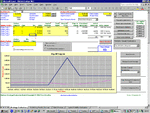Good question Stevet
I agree that the reason options are normally sold is to cover existing positions in the underlying stock and to sell naked (i.e. uncovered) options is very risky
While understanding the theory expounded in this thread I must admit I’ve always looked at this in a much simpler way. I look for one big win to outbalance several small loses.
I trade (buy/sell) options for several reasons and with a fairly basic technique.
a. Your investment loss is limited to your original purchase while your potential profit is (relatively) unlimited.
b. The stocks covered by options are limited to heavily traded shares, which allows TA to be reliable.
c. Only a few stocks need be watched because some of the optioned stocks are not very interesting. I regularly watch around 8 or 10 stocks only.
d. Leverage of buying 1000 shares for a small fee makes it very attractive.
My technique is, as I said, quite basic.
a. If the price is trending follow it up (or down)
b. Use trendlines, support and resistance levels, volume and some indicators to look for trend reversals.
c. Set strict stop losses and stick to them. Cut your losses and run your profits not the other way round.
d. Understand that you don’t win every time.
e. Buy at, or near, the money with time to run. Time is the enemy.
Example:
CGNU – around end of April this broke the support at 705p in a steep down trend on big volume. Early May tried to break back above 705 and failed, this looked like a pullback as it resumed the down trend, so on 13th May I checked out the option prices.
July 650 Puts were 18p bid and 23.5p ask. Share price 678
Breakeven as follows:
Buy 1 contract - £235
Buy commission - £15
Sell commission - £15
Clearing fee in & out - £3.60
Total - £268.60
So the bid price had to get to 27p for me to make a profit. What’s the chance? Nice downward trendline - the price needed to drop to around 660 to see a profit. Set a stop loss of 705 at which time the bid would be around 11p if I had to bail out. FTSE was near the top of the Bollinger (and the recent trading range) so was likely to go down and nothing else looking interesting. Look tomorrow (14th) to see what CGNU is doing – opened at yesterdays close then down - so let’s give it a go!!
Despite a few concerns afterwards the price never tested the resistance and after 28th May really started to motor. Today the share price is 571p and the option is 79p showing a profit of £521.
What next? Another good question – still around 36 days to expiry and I get twitchy at less than 20 – so I can hang on for a bit. Unfortunately the drop has not generated a stop loss on the chart such as an accepted high, so is 30p too tight (600p)?
So – I got lucky with that one but recently messed up on STAN; a nice trendline break and pull back but I got in too late with a Call and as soon as it got into profit we had another reversal so I bailed out with a small loss. However I was looking at the wrong scale and another 20 days might have been seen a profit. It really does your mind!
When you get one right you think you have got it licked before it turns round and bites your ….
Currently looking at STAN Puts, AL. Puts, BAT Puts, IMT Puts, LLOY Puts and Calls
How’s that for Stone Age trading??

